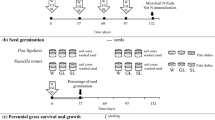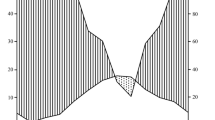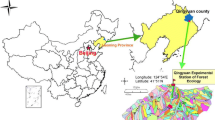Abstract
The aim of this study was to monitor the concentration of some plant secondary metabolites, such as low- and high-molecular-weight phenolics, condensed tannins (proanthocyanidins), and sesqui-, di- and triterpenes, in litter (L), fermentation (F) and humified (H) layers of the soil organic horizon in stands dominated by silver birch (Betula pendula Roth.), Norway spruce (Picea abies (L.) Karst.) and Scots pine (Pinus sylvestris L.), and from samples taken from birch leaves and spruce and pine needles. Concentrations of low- and high-molecular-weight phenolics and terpenes from the four most dominant species of ground vegetation taken from the stands were also determined. In general, the L layer showed higher concentrations of both phenolic compounds and terpenes than the F and H layers did. Concentrations of terpenes decreased relatively more with soil depth than did concentrations of total phenolics (=low + high) or condensed tannins. Of the total phenolics, the proportion of low-molecular-weight phenolics increased from the L to the H layer with all tree species. Concentrations of all terpenes were highest under pine and lowest under birch. Concentrations of the studied secondary metabolites in the ground vegetation species were similar under different tree species. Blueberry (Vaccinium myrtillus L.) and lingonberry (Vaccinium vitis-idaea L.) contained considerably higher concentrations of total phenolics than did feather moss (Pleurozium schreberi (Brid.) Mitt.) and wavy hair-grass (Deschampsia flexuosa (L.) Trin.). Concentration of total phenolics in soil correlated positively with soil respiration and microbial biomass C, and terpenes showed positive correlation with soil C-to-N ratio.



Similar content being viewed by others
References
Barford C, Lajtha K (1992) Nitrification and nitrate reductase activity along a secondary successional gradient. Plant Soil 145:1–10
Box JD (1981) Investigation of the Folin-Ciocalteu phenol reagent for the determination of polyphenolic substances in natural waters. Water Res 17:511–525
Bradley RL, Titus BD, Preston CP (2000) Changes to mineral N cycling and microbialcommunities in black spruce humus after additions of (NH4)2SO4 and condensed tannin extracted from Kalmia angustifolia and balsam fir. Soil Biol Biochem 32:1227–1240
Bremner JM, McCarty GW (1988) Effects of terpenoids on nitrification in soil. Soil Sci Soc Am J 52:1630–1633
Dijkstra EF, Boon JJ, Van Mourik JM (1998) Analytical pyrolysis of a soil profile under Scots pine. Eur J Soil Sci 49:295–304
Fierer N, Schimel JP, Cates RG, Zou J (2001) Influence of balsam poplar tannin ractions on carbon and nitrogen dynamics in Alaskan taiga floodplain soils. Soil Biol Biochem 33:1827–1839
Folin O, Ciocalteu V (1927) On tyrosine and tryptophane determinations in proteins. J Biol Chem 73:627–650
Gallet C, Lebreton P (1995) Evolution of phenolic patterns in plants and associated litters and humus of a mountain forest ecosystem. Soil Biol Biochem 27:157–165
Harborne JB (1997) Role of phenolic secondary metabolites in plants and their degradation in nature. In: Cadisch G, Giller KE (eds) Driven by nature: plant litter quality and decomposition. CAB International, Wallingford UK, pp 67–74
Haslam E (1989) Plant Polyphenols-Vegetable Tannins Revisited. In: Phillipson JD, Ayres DC, Baxter H (eds) Chemistry and pharmacology of natural products. Cambridge University Press, Cambridge, p 230
Hernes PJ, Benner R, Cowie GL, Goñi MA, Bergamaschi BA, Hedges JI (2001) Tannin diagenesis in mangrove leaves from a tropical estuary: a novel molecular approach. Geochim Cosmochim Acta 65:3109–3122
Kainulainen P, Holopainen JK (2002) Concentrations of secondary metabolites in Scots pine needles at different stages of decomposition. Soil Biol Biochem 34:37–42
Kanerva S, Smolander A (2007) Microbial activities in forest floor layers under silver birch, Norway spruce and Scots pine. Soil Biol Biochem 39:1459–1467
Kanerva S, Kitunen V, Kiikkilä O, Loponen J, Smolander A (2006) Response of soil C and N transformations to tannin fractions originating from Scots pine and Norway spruce needles. Soil Biol Biochem 38:1364–1374
Kraus TEC, Dahlgren RA, Zasoski RJ (2003) Tannins in nutrient dynamics of forest ecosystems—a review. Plant Soil 256:41–66
Kraus TEC, Zasoski RJ, Dahlgren RA, Horwath WT, Preston CM (2004a) Carbon and nitrogen dynamics in a forest soil amended with purified tannins from different plant species. Soil Biol Biochem 36:309–321
Kraus TEC, Zasoski RJ, Dahlgren RA (2004b) Fertility and pH effects on polyphenol and condensed tannin concentrations in foliage and roots. Plant Soil 262:95–109
Kumar R, Horigome T (1986) Fractionation, characterization, and protein-precipitating capacity of the condensed tannins from Robinia pseudo acacia L. leaves. J Agr Food Chem 34:487–489
Langenheim JH (1994) Higher plant terpenoids: a phytocentric overview of their ecological roles. J Chem Ecol 20:1223–1280
Lorenz K, Preston CM, Raspe S, Morrison IK, Feger KH (2000) Litter decomposition and humus characteristics in Canadian and German spruce ecosystems: information from tannin analysis and 13C CPMAS NMR. Soil Biol Biochem 32:779–792
Maie N, Behrens A, Knicker H, Kögel-Knabner I (2003) Changes in the structure and protein binding ability of condensed tannins during decomposition of fresh needles and leaves. Soil Biol Biochem 35:577–589
Nierop KGJ, Preston CM, Verstraten JM (2006) Linking the B ring hydroxylation pattern of condensed tannins to C, N and P mineralization. A case study using four tannins. Soil Biol Biochem 38:2794–2802
Northup RR, Yu Z, Dahlgren RA, Vogt KA (1995) Polyphenol control of nitrogen release from pine litter. Nature 377:227–229
Northup RR, Dahlgren RA, McColl JG (1998) Polyphenols as regulators of plant–litter–soil interactions in northern California’s pygmy forest: a positive feedback? Biogeochem 42:189–220
Obst JR (1998) Special (secondary) metabolites from wood. In: Bruce A, Palfreyman JW (eds) Forest products biotechnology. Taylor & Francis, London, UK, pp 151–165
Ossipova S, Ossipov V, Haukioja E, Loponen J, Pihlaja K (2001) Proanthocyanidins of mountain birch leaves: quantification and properties. Phytochem Anal 12:128–133
Paavolainen L, Kitunen V, Smolander A (1998) Inhibition of nitrification in forest soil by monoterpenes. Plant Soil 205:147–154
Pohjola J (1993) A headspace gas chromatographic study on the variation of needle volatile terpenes in Scots pine (Pinus sylvestris L.). Pharmacognosy Division, Department of Pharmacy, University of Helsinki, Finland, p 177
Priha O (1999) Microbial activities in soils under Scots pine, Norway spruce and silver birch. Finnish Forest Research Institute, Research Papers 731, p 50
Priha O, Smolander A (1999) Nitrogen transformations in soil under Pinus sylvestris, Picea abies and Betula pendula at two forest sites. Soil Biol Biochem 31:965–977
Priha O, Grayston SJ, Hiukka R, Pennanen T, Smolander A (2001) Microbial community structure and characteristics of the organic matter in soils under Pinus sylvestris, Picea abies and Betula pendula at two forest sites. Biol Fertil Soils 33:17–24
Rowe JW (1989) Natural products of woody plants: chemicals extraneous to the lignocellulosic cell wall, vols. I, II. Springer, New York
Schimel JP, Van Cleve K, Cates RG, Clausen TP, Reichardt PB (1996) Effects of balsam poplar (Populus balsamifera) tannins and low molecular weight phenolics on microbial activity in taiga floodplain soil: implications for changes in N cycling during succession. Can J Bot 74:84–90
Smolander A, Kitunen V (2002) Soil microbial activities and characteristics of dissolved organic C and N in relation to tree species. Soil Biol Biochem 34:651–660
Smolander A, Loponen J, Suominen K, Kitunen V (2005) Organic matter characteristics and C and N transformations in the humus layer under two tree species, Betula pendula and Picea abies. Soil Biol Biochem 37:1309–1318
Smolander A, Ketola RA, Kotiaho T, Kanerva S, Suominen K, Kitunen V (2006) Volatile monoterpenes in soil atmosphere under birch and conifers: Effects on soil N transformations. Soil Biol Biochem 38:3436–3442
Stark S, Julkunen-Tiitto R, Kumpula J (2007) Ecological role of reindeer summer browsing in the mountain birch (Betula pubescens ssp. czerepanovii) forests: effects on plant defense, litter decomposition, and soil nutrient cycling. Oecology 151:486–498
Suominen K, Kitunen V, Smolander A (2003) Characteristics of dissolved organic matter and phenolic compounds in forest soils under silver birch (Betula pendula), Norway spruce (Picea abies) and Scots pine (Pinus sylvestris). Eur J Soil Sci 54:287–293
Swift MJ, Heal OW, Anderson JM (1979) Decomposition in terrestrial ecosystems. Blackwell Scientific Publications, Oxford
Terrill TH, Rowan AM, Douglas GB, Barry TN (1992) Determination of extractable and bound condensed tannin concentrations in forage plants, protein concentrate meals and cereal grains. J Sci Food Agric 58:321–329
Valachovic YS, Caldwell BA, Cromack K Jr, Griffiths RP (2004) Leaf litter chemistry controls on decomposition of Pacific Northwest trees and woody shrubs. Can J For Res 34:2131–2147
Waterman PG, Mole S (1994a) Analysis of phenolic plant metabolites. In: Lawton JH, Likens GE (eds) Methods in Ecology. Blackwell Scientific Publications, Oxford, pp 36–43
Waterman PG, Mole S (1994b) Analysis of phenolic plant metabolites. In: Lawton JH, Likens GE (eds) Methods in Ecology. Blackwell Scientific Publications, Oxford, pp 92–95
White CS (1986) Volatile and water-soluble inhibitors of nitrogen mineralization and nitrification in a ponderosa pine ecosystem. Biol Fertil Soils 2:97–104
White CS (1991) The role of monoterpenes in soil nitrogen cycling processes in ponderosa pine. Biogeochem 12:43–68
White CS (1994) Monoterpenes: their effects on ecosystem nutrient cycling. J Chem Ecol 20:1381–1406
Acknowledgements
We are grateful to Anneli Rautiainen and Pauli Karppinen for excellent laboratory work, to Anne Siika for making the figures and to Dr. Joann von Weissenberg for checking the English language of this paper. This study was supported by the Academy of Finland and the Emil Aaltonen Foundation.
Author information
Authors and Affiliations
Corresponding author
Rights and permissions
About this article
Cite this article
Kanerva, S., Kitunen, V., Loponen, J. et al. Phenolic compounds and terpenes in soil organic horizon layers under silver birch, Norway spruce and Scots pine. Biol Fertil Soils 44, 547–556 (2008). https://doi.org/10.1007/s00374-007-0234-6
Received:
Accepted:
Published:
Issue Date:
DOI: https://doi.org/10.1007/s00374-007-0234-6




